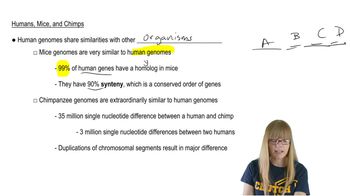Table of contents
- 1. Introduction to Genetics51m
- 2. Mendel's Laws of Inheritance3h 37m
- 3. Extensions to Mendelian Inheritance2h 41m
- 4. Genetic Mapping and Linkage2h 28m
- 5. Genetics of Bacteria and Viruses1h 21m
- 6. Chromosomal Variation1h 48m
- 7. DNA and Chromosome Structure56m
- 8. DNA Replication1h 10m
- 9. Mitosis and Meiosis1h 34m
- 10. Transcription1h 0m
- 11. Translation58m
- 12. Gene Regulation in Prokaryotes1h 19m
- 13. Gene Regulation in Eukaryotes44m
- 14. Genetic Control of Development44m
- 15. Genomes and Genomics1h 50m
- 16. Transposable Elements47m
- 17. Mutation, Repair, and Recombination1h 6m
- 18. Molecular Genetic Tools19m
- 19. Cancer Genetics29m
- 20. Quantitative Genetics1h 26m
- 21. Population Genetics50m
- 22. Evolutionary Genetics29m
15. Genomes and Genomics
Comparative Genomics
Problem 21
Textbook Question
Textbook QuestionResearchers have compared candidate loci in humans and rats in search of loci in the human genome that are likely to contribute to the constellation of factors leading to hypertension [Stoll, M., et al. (2000). Genome Res. 10:473–482]. Through this research, they identified 26 chromosomal regions that they consider likely to contain hypertension genes. How can comparative genomics aid in the identification of genes responsible for such a complex human disease? The researchers state that comparisons of rat and human candidate loci to those in the mouse may help validate their studies. Why might this be so?
 Verified Solution
Verified SolutionThis video solution was recommended by our tutors as helpful for the problem above
Video duration:
2mPlay a video:
211
views
Was this helpful?
Related Videos
Related Practice
Showing 1 of 2 videos


